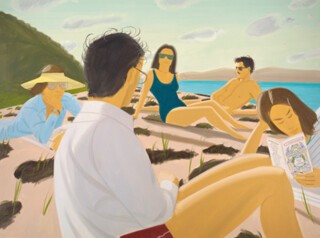A selection of works done across sixty years by the New York painter Alex Katz has left Tate St Ives for the opposite end of southern England. The upper galleries of Margate’s recently opened Turner Contemporary (where the show continues until 13 January 2013) make a handsome destination. You pass from big windows that give onto the stark North Sea with its distant forests of wind farms, to enter two big skylit galleries, no less stirringly stark. In one, a six-metre-wide polyptych of girls in chic swimsuits, hot-hued against turquoise waters, looms over further imagery in a long vacation, blissed-out beach party, drop-dead-glamorous mode. The other gallery is dominated by an ocean panorama, looking across a huge, dark, cold Atlantic to a wooded Maine coast. You can feel Katz’s six-inch brush at work, slathering on that swell of indigo, just as you are brought up against stout, compact blocks of flesh tone and magenta swimwear in the polyptych. These tactilities don’t come through in reproductions of Katz. So you get to encounter some well laid paint, and these hefty, imposing marines shine back a new dignity on the seaside without, as you step back into melancholic Margate. Maybe they encourage you to complete your visit with some supplementary spending; the gallery, visitor and painter are all contributing to the ‘South Coast regeneration’ effect. Yet my experience on some level nags at me. An improper question keeps surfacing. Is this as good as it gets? Is it enough for paintings to be functioning participants in this closed circle of satisfaction?
Katz is for many fellow painters an exemplary figure, and the reasons shine out in this show. He loves freshly laid, bright-from-the-tube oil paint and finds many ways to let it sing. This entails plotting, with fastidious care, how planes of pigment might come together to make up an appearance and how to structure this appearance within a snazzy image crop. Within these preset confines his brushwork proceeds swiftly and cleanly, alla prima as far as possible. His optical tuning is exquisite. An effect slightly mistranslated in all available reproductions of Islesboro Ferry Slip, the show’s poster image, is the way a blue jacket soaks up sunlight like a heavy sponge while pumping out a fat radiance all of its own. The show has many moments of such palpable beauty, a beauty distinctive to representational art.
They make me feel ill at ease with beauty. Can I account for this historically? Joining the mini-retrospective of Katz’s own work, a further gallery presents a personal selection the Tate asked him to make from its holdings. Katz casts his net wide but foregrounds Sickert and William Nicholson, both in his eyes ‘highly civilised, but very good provincial painters’, and among his juniors, Luc Tuymans. All of these lean to what you might call the terse tendency in painting – the ethos pivoted on impact, economy and self-possessed cool that you can trace back to Manet and ultimately Velázquez. A tendency rather than a tradition, I’d guess: maybe Katz picked up parts of his own version from Americans such as Milton Avery, but it seems he largely invented his attitude from European canvases studied in museums. Jump to the postmodern world of Tuymans, and the connotations of ‘terse’ have changed. The economically reduced image has come to mean the degenerated image: a whole historical-cum-philosophical pathos, a great baggage of noir, gets attached to it.
We have got used to putting our faith in suspicion, and that rubs strangely against Katz’s swift, slick images of wealthy Brooklynites on holiday in Maine. We scan them for irony. As Alison Gingeras points out in a catalogue essay, Katz is unusually frank, in modern art-scene terms, in stating the upper-middle-classness of his own milieu.* ‘His is a politics of honesty,’ she claims: if there’s irony anywhere, it’s directed at the self-deluding rhetorics of that art scene. Behind Katz’s affirmation of moneyed style, however, I see his art as bearing its own kind of pathos. Saul Steinberg once drew a profile view of a hunky, hard-jawed executive with his skull shown in cross-section, revealing a timid little rabbit peeping out between his eyelids. When it comes to Katz’s painting, the rabbit is the draughtsmanship. It scampers after fleeting postures and groupings, trying to make good on them from memory: commonly, refusing to lean on the camera, it winds up faintly wonky.
And that wonkiness asks to be cherished. It is a way of protesting the artist’s innocence. It dissociates him from the photo-canniness of the Pop generation that succeeded his own. It asserts that the type of bright, brisk images he wants to put forward are emphatically manual acts and in that way it helps him approach his impossible, wistful objective. ‘I’ve always thought that music reaches the present, but painting doesn’t, and that’s what I wanted to do. I don’t think it can ever do it, but the wish is there.’ Romantic dreams of lightness, then, run through the highly consistent oeuvre on show at Margate. They can be traced back to a couple of faux-naïf scenes of suburban home life painted in his early twenties and some charming little coloured paper collages done soon after. Maybe he starts to close in on them in the later, vaster canvases, starting with that polyptych of bathers from 1984. From more recent years, there is a huge, subtly harmonised marine of breakers on a beach and some outsize homages to Monet’s waterlilies.
But the dream these project strikes me as vapid, or at least best held at arm’s length: give me rather the traces of struggle, of confronted anxiety, evident in Katz’s little studies from nature on board. Katz bags the London painters of 1910 as ‘provincial’ with the authority of a contender from the mid-century metropolis of art, a painter from life who held his own against every abstractionist from Pollock to Stella while ‘keeping the paint as good as it was in the can’. But at this stage, his fanfares of visual innocence induce the thought that painting is everywhere provincial: tuned in the same terse key as Tuymans, they mock the latter’s claim to paint songs of experience, and the terrain of pictorial ambitions stretching in between looks flatter as a result. Does the pat almost success of his canvases ever give him the blues in this way? Maybe that’s why he likes to intersperse them with cheeky free-standing cut-out figures, painted on aluminium. There’s a thought of provocation, or even of exit there: a fey thought, however, half-smirk, half-sigh, an exit into the gift shop.
Send Letters To:
The Editor
London Review of Books,
28 Little Russell Street
London, WC1A 2HN
letters@lrb.co.uk
Please include name, address, and a telephone number.



